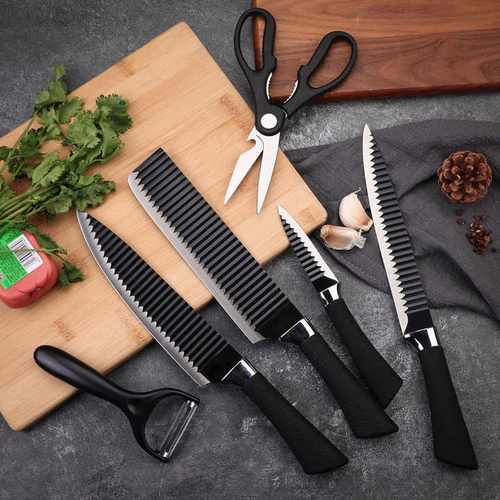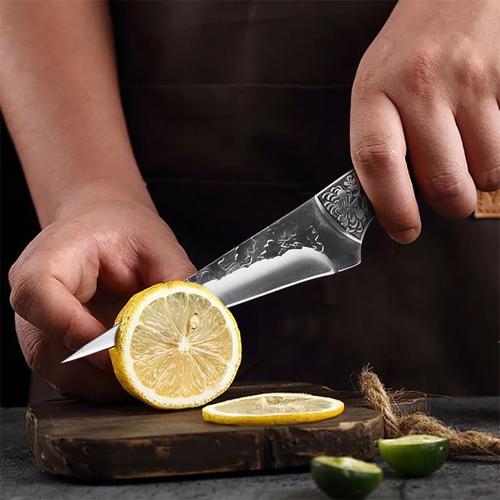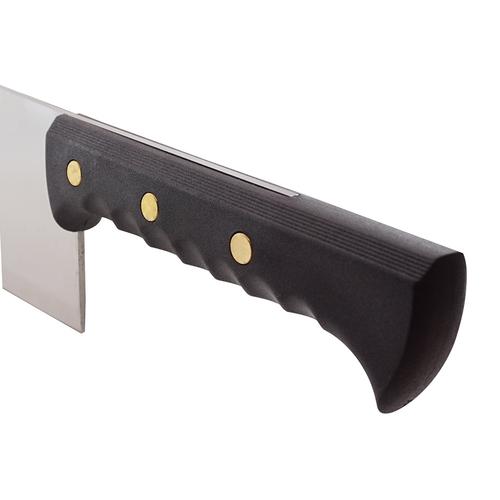

Views: 222 Author: Ella Publish Time: 2025-04-30 Origin: Site








Content Menu
● The Science Behind Knife Steel Performance
● Comprehensive Blade Material Analysis
>> Stainless Steel: The Reliable Workhorse
>> Carbon Steel: The Sharpness Specialist
>> High-Carbon Stainless: The Balanced Performer
>> Damascus Steel: The Artisan's Choice
>> Ceramic Blades: The Precision Specialist
>> Titanium-Coated Blades: The Modern Innovator
● Advanced Selection Guide: Matching Steel to Technique
● Pro-Level Maintenance Protocols
● Future Trends in Knife Metallurgy
>> 1. Can I use a ceramic knife on marble cutting boards?
>> 2. Why do some carbon steel knives have a kurouchi finish?
>> 3. How does blade material affect knife balance?
>> 4. Are there food safety concerns with different blade materials?
>> 5. Can I restore a severely rusted carbon steel knife?
The chef's knife is the workhorse of any kitchen, and its blade material determines whether it becomes a trusted ally or a frustrating liability. From the home cook preparing weeknight dinners to the professional chef executing intricate cuts, understanding blade materials unlocks culinary precision. This guide goes beyond basic comparisons to explore how molecular structures, manufacturing techniques, and cutting-edge innovations affect knife performance.

Blade performance stems from three key metallurgical properties:
1. Hardness (Rockwell Scale): Determines edge retention
2. Toughness: Resistance to chipping and cracking
3. Corrosion Resistance: Protection against rust and pitting
Premium knives balance these properties through precise alloy mixtures and heat treatment. For instance, adding vanadium increases wear resistance, while molybdenum enhances machinability. Modern powder metallurgy allows combinations previously impossible with traditional forging methods.
Metallurgical Composition:
Typically contains 12-15% chromium with 0.5-1% carbon. Premium versions add molybdenum or vanadium.
Performance Insights:
- Edge Retention: 55-58 HRC (Rockwell hardness) needs weekly honing for heavy users
- Food Release: Varies by finish - hollow edges reduce sticking
- Best Uses: General prep, acidic foods, moist environments
Maintenance Hack:
Use baking soda paste to remove stubborn stains without damaging the chromium oxide layer.
Metallurgical Composition:
1-1.5% carbon content with trace manganese/silicon. No chromium content.
Performance Insights:
- Edge Sharpness: Achieves 60+ HRC for surgical precision
- Patina Development: Creates natural anti-stick surface over time
- Best Uses: Butchery, precision vegetable work, dry ingredients
Expert Tip:
Forced patina creation using coffee grounds or mustard protects the blade while adding character.
Metallurgical Composition:
0.8-1% carbon with 13-15% chromium and often vanadium additives.
Performance Insights:
- Edge Life: Maintains sharpness 3-5x longer than basic stainless
- Stain Resistance: Withstands 30+ minutes of moisture exposure
- Best Uses: All-day professional use, wet/dry ingredient switching
Construction Methods:
Pattern-welded (modern) vs true crucible (historical). Most modern versions combine high-carbon core with stainless layers.
Performance Insights:
- Edge Geometry: Allows extremely acute angles (10-12° per side)
- Food Separation: Patterned surface reduces suction effect
- Best Uses: Presentation cuts, slicing delicate proteins
Material Science:
Zirconium oxide sintered at 1400°C creates microcrystalline structure.
Performance Insights:
- Edge Longevity: Maintains sharpness 10x longer than steel
- Limitations: Avoid lateral torque - never twist while cutting
- Best Uses: Sushi preparation, herb chiffonade, boneless proteins
Technology Breakdown:
Physical Vapor Deposition (PVD) coating 3-5 microns thick.
Performance Insights:
- Friction Reduction: Glide through sticky foods like cheese
- Color Options: Black, bronze, and blue coatings available
- Best Uses: High-moisture environments, decorative plating

| Cooking Technique | Ideal Blade Material | Angle Recommendation |
|---|---|---|
| Rock Chopping | Forged High-Carbon Stainless | 18-20° |
| Push Cutting | Carbon Steel | 15-17° |
| Slicing Smoked Salmon | Ceramic | 20-22° |
| Breaking Down Poultry | Stainless Damascus | 16-18° |
| Julienne Vegetables | Powdered Steel | 12-15° |
Sharpening Frequency Guide:
| Material | Home Cook | Professional |
|---|---|---|
| Stainless Steel | 6 months | 6 weeks |
| Carbon Steel | 4 months | 4 weeks |
| Ceramic | 2 years | 1 year |
| Damascus | 5 months | 5 weeks |
Storage Solutions:
- Magnetic strip: Ideal for carbon steel (promotes airflow)
- Knife block: Best for stainless (prevents edge contact)
- Leather sheath: Essential for Damascus protection
1. Metallic Glass Alloys: Amorphous structures with extreme hardness
2. Graphene Coatings: Atom-thick carbon layers for frictionless cutting
3. Self-Sharpening Nanostructures: Microscopic serrations that regenerate
4. Hybrid Ceramic-Metal Composites: Combine flexibility with edge retention
Budget Buy:
Victorinox Fibrox (Stainless Steel) - $50
Professional Choice:
Shun Premier (Damascus-clad VG-MAX) - $200
Luxury Investment:
Miyabi Birchwood SG2 (Microcarbide MC66) - $400
Specialist Tool:
Kyocera Revolution (Ceramic) - $120
Choosing a chef knife based on blade material is about understanding your own needs as much as the steel itself. Stainless steel offers reliability and ease of care, making it ideal for most home cooks. Carbon steel rewards those willing to invest in maintenance with unmatched sharpness. High-carbon stainless steel blends the best qualities of both, while Damascus steel brings artistry and performance together. Ceramic and titanium-coated knives serve specialized roles in the kitchen.No single blade material is “best” for everyone. The right choice depends on your cooking style, willingness to maintain your tools, and the types of foods you prepare most often. By matching your needs to the strengths of each material, you'll find a chef knife that feels like a natural extension of your hand-making every meal a pleasure to prepare.

Avoid hard stone surfaces. Use end-grain wood or soft plastic boards to prevent micro-chipping.
The blacksmith's scale left on the blade enhances rust protection and reduces food sticking.
Denser materials like carbon steel create forward balance for chopping, while stainless offers neutral balance for precision.
Non-porous ceramics and properly maintained stainless steels offer the most hygienic surfaces for raw proteins.
Use electrolytic rust removal (white vinegar bath with battery charger) followed by complete reprofiling.